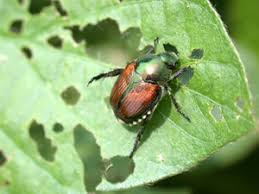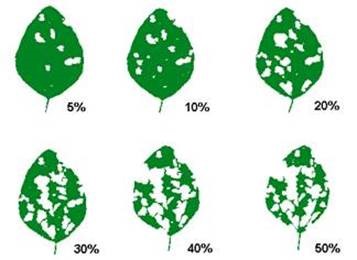Beans got off to a rough start and growers are seeing some unexpected issues pop up.
Temperatures across much of Illinois continue to be above normal during June. These conditions may deter you from scouting fields, but it is especially important to observe growing crops to diagnose insect and disease pressure before it reaches economic levels.
During late vegetative and early flowering stages of soybeans there are several things to look for while scouting. Insects of concern that may be present include Japanese beetles (insert), bean leaf beetles, soybean aphids and spider mites. Each of these insects causes different kinds of foliar damage to soybean plants, but ultimately can limit growth and development if levels are severe.


What about Japanese Beetles in soybeans? The economic threshold on R1-R5 soybeans for Japanese beetle feeding is 15% defoliation. Once again, here is my favorite chart for estimating soybean defoliation:
A foliar applied insecticide can protect yield if pest populations are increasing at the time of identification. Consult a reputable scouting guide for economic thresholds if any of the aforementioned or other insects are found damaging fields. Soybean plants can withstand some level of foliar feeding with little to no yield impact, but attacking any pest problem before it reaches damaging levels is important to achieving top yields.

Each season brings a different environment and disease, but there is usually some level of bacterial or fungal disease present in the soybean canopy each season. When scouting soybeans for disease go to areas of the field that appear abnormal in color or size and examine leaves, stems and roots for symptoms. Upon closer inspection any necrotic or discolored area of leaf tissue could indicate possible disease. Phytophthora root and stem rot (insert), white mold, downy mildew and frogeye leaf spot are common fungal diseases that can be found during this period of growth.
Weather conditions, including wind and rain, can cause bacterial leaf infections which can be confused with fungal diseases. Foliar fungicide applications do not work to control bacterial diseases but may prevent fungal disease from developing. If phytophthora or stem diseases are found foliar fungicide applications will not provide in-season protection or control. These diseases can only be prevented with the use of seed treatments and, in some instances, through seed selection. But even these strategies are not an absolute cure-all.
Consider taking a pictorial scouting guide or smart phone app to the field to help identify insects and diseases. Some issues can easily be confused with other issues like nutrient or herbicide problems. Take pictures to record any problems for reference. When in doubt contact a local supplier for additional information. You can always submit a plant sample to the University of Illinois Plant Clinic for help in identifying a plant problem.
University of Illinois plant pathologist Nathan Kleczewski recently posted a blog on soybean diseases appearing across the state.


 and then
and then